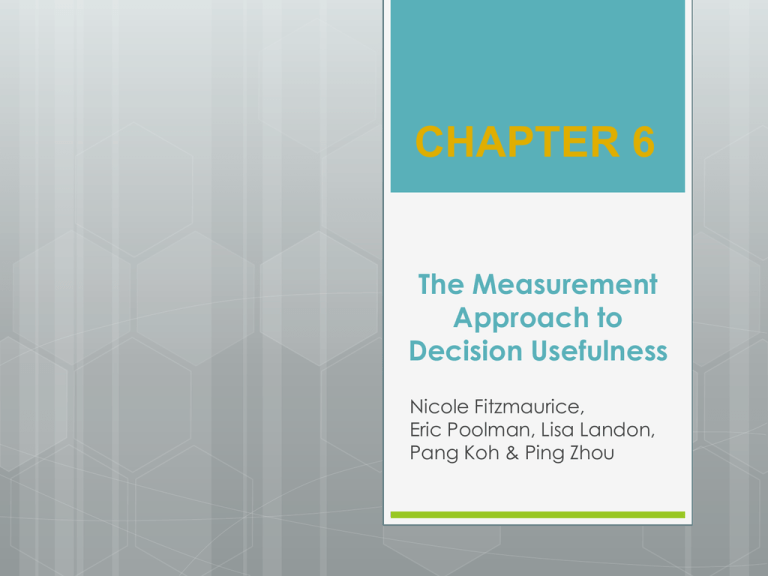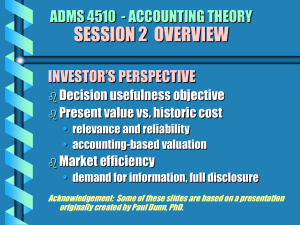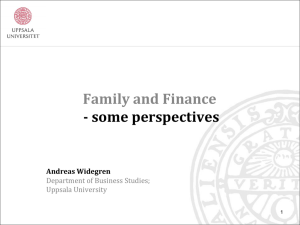Chapter 6: The Measurement Approach
advertisement

CHAPTER 6
The Measurement
Approach to
Decision Usefulness
Nicole Fitzmaurice,
Eric Poolman, Lisa Landon,
Pang Koh & Ping Zhou
"is an approach to
financial reporting
under which
accountants undertake
responsibility to
incorporate current
values into the financial
statements proper,
providing that this can
be done with
reasonable reliability,
thereby recognizing an
increased obligation to
assist investors to
predict firm
performance & value."
The
Measurement
Approach
to decision
usefulness
MARKET EFFICIENCY/INEFFICIENCY
Security
market is not as efficient as originally
believed
Does the theory of rational decision-making
underlie an average investor’s behavior?
Do securities reflect publicly available
information?
The Measurement Approach can reduce extend
of inefficiency and non-rational investor
behaviour.
BEHAVIOURAL FINANCE
Limited
Attention
Do not have time or ability to process all available
information
Overconfidence
Overestimate precision of information that was selfcollected
Representativeness
Assigns too much weight to evidence consistent with
individual’s impression of the population from which
the evidence is drawn
BEHAVIOURAL FINANCE CONT’D
Self-attribution
Feels that good decision outcomes are due to their
ability and bad outcomes are not their fault
Motivated
bias
Reasoning
Accept at face value information that is consistent
with their preferences and beliefs (GN).
All these behaviours are inconsistent with securities
market efficiency and rational decision theory
States:
“an
investor
considering a
risky investment
(a ‘prospect’) will
separately
evaluate
prospective
gains and losses”
Results in narrow
framing
Utility defined
over deviation
from zero
The Prospect
Theory
DISPOSITION EFFECT
Risk-taking
Risk-averse
IS BETA DEAD?
Under
CAPM, stock’s beta is the sole
firm-specific determinant of expected
returns on that stock
Fama and French study
Beta
had little ability to explain stock returns
B/M (book-to-market value) more
explanatory
IS BETA DEAD?
Other studies conclude
Kohari, Shaken and Sloan
B/M relatively weak in predicting returns
Beta significant over longer periods
Behavioural
Finance
Beta and B/M positively related to future
share return
Note: Beta changes over time; is not static
EXCESS STOCK MARKET VOLATILITY
Concerns
about securities market efficiency
come from evidence of excess stock prove
volatility at market level
Shiller (1981) argued that the higher aggregate
expected dividends are, the more investors will
invest in the market
Found variability of market index was greater
than aggregate dividends
Thus, market inefficient
EXCESS STOCK MARKET VOLATILITY
DeLong,
They
Sheifer, Summer &Waldmann
assume capital market with both
rational and positive feedback investors
Believe rational investors anticipate action of
less experienced investors and “jump on
band wagon”
Thus, excess volatility
STOCK MARKET BUBBLES
What
is a stock bubble?
Represents
an extreme case of market volatility
Where share prices rise far above
fundamental values
Shiller
(2000) investigated how they are
derived
Will eventually burst
Causing
serious challenges to the market
efficiency theory
6.2.6 EFFICIENT SECURITIES
MARKET ANOMALIES
Market
does not respond to
accounting information exactly as
the efficiency theory predicts
These inconsistencies are called
efficient securities market anomalies
Post-Announcement Drift
Market Response to Accruals
6.2.7 IMPLICATIONS OF SECURITIES MARKET
INEFFICIENCY FOR FINANCIAL REPORTING
Improved
financial reporting will speed up
share price response to the full
information content of financial
statements
Examples of improved reporting include:
Full disclosure of low persistence
components of earnings
High quality MD&A
Moving current value information into
the financial statements proper
6.2.8 DISCUSSION OF MARKET EFFICIENCY
VERSUS BEHAVIORAL FINANCE
Variety
of investor activities prevent
a totally efficient market
New information results in under and
overreaction in share price
Despite being fully rational, some
investors don't consider information
due to the manner and place that it
is disclosed in the financial
statements
6.2.9 LIMITS TO ARBITRAGE
Efficient
market anomalies don't die out
over time
Transaction costs
Bid-ask spreads
Large amount of time and effort
required to monitor and analyze all of
the information required to exploit the
mispricing
Idiosyncratic risk
6.2.10 A DEFENSE OF AVERAGE
INVESTOR RATIONALITY
Inability
to interpret the significance
of market activity
Estimation risk related to making
decisions results in conservative
decisions
Investors are viewed as boundedly
rational
6.2.11 CONCLUSIONS ABOUT
SECURITIES MARKET EFFICIENCY
Securities
markets are not fully efficient
Markets are generally close to full
efficiency
Accountants can continue to rely on
supplementary disclosures on financial
statement notes and MD&A as an
important way to inform the market
6.3 OTHER REASONS SUPPORTING A
MEASUREMENT PERSPECTIVE
Securities
markets not that efficient
Investors need more help in
assessing the future performances
Clean Surplus Theory (Ohlson) shows
that the market value of the firm
can expressed using the income
statement or the balance sheet.
6.4 THE VALUE RELEVANCE OF
FINANCIAL STATEMENT INFORMATION
Significance
of statistics to measure value
relevance, like Earnings Ratio Coefficient
Does this mean that the relevance of ERC
is deteriorating?
Market Model, Landsman and Maydew
(2002)
How is it possible for the ERC to fall but the
abnormal return increase?
6.5 OHLSON’S CLEAN SURPLUS THEORY
Expresses
firm value in terms of accounting
variables
Balance sheet components (net book value)
Income statement components (goodwill)
Firm value = net book value ± present value of
future abnormal earnings (goodwill)
2 Assumptions
Ideal conditions, including dividend
irrelevancy
All gains and losses go through net income
(thus the term “clean surplus”)
6.5.1 THREE FORMULAS FOR FIRM VALUE
1. Firm value = PV of expected future dividends
The fundamental determinant of firm value
2. Firm value = PV of expected future cash flows
3. Firm value = net book value ± PV of expected
future abnormal earnings (goodwill)
The clean surplus theory model
ALL THREE formulas will give the SAME firm
value in principle.
UNBIASED VS BIASED ACCOUNTING
Unbiased
accounting
All assets and liabilities are valued at current
value
Unrecorded goodwill = zero ; NBV = firm value
Biased accounting
Assets and liabilities are not valued at current
value
E.g., historical cost accounting, conservative
accounting
Unrecorded goodwill ≠ zero ; NBV ≠ firm value
BIASED ACCOUNTING
(STRAIGHT-LINE AMORTIZATION)
PA0 (firm value) = $260.33 (amortized across 2 years)
Straight-line amortization in year 2 = $130.16
NBV1 = 100 + 130.16 = $230.16
E{NI2} = (100 x 0.10) + 0.5 (100 – 130.16) + 0.5 (200 –
130.16) = $29.84
E{ox2a} = 29.84 – (0.10 x 230.16) = $6.82
NI on book Accretion of discount
g1 = 6.82/1.10 = $6.20
PA1 = 230.16 + 6.20 = $236.36 (would be the same
under formula 1 and 2 as in pg210 of the textbook)
RELATION TO MEASUREMENT
APPROACH
Ohlson’s
clean surplus theory
supports measurement approach
Increased use of current value
accounting moves more of firm
value on balance sheet.
Thus, less need to estimate
unrecorded goodwill
6.5.2 EARNINGS PERSISTENCE
FO
introduced earnings dynamic formula to
calculate earnings persistence
0≤ω≤1
is the persistence parameter
vt-1 represents effect of other information
becoming known in year t-1;
vt-1=0 when accounting is unbiased
are the effects of state realization in period
t on abnormal earnings
FIRM VALUE UNDER PERSISTENCE
PA1
= bvt + (α x oxta) ;
= $236.36 + (0.4/1.1 x -$50)
= $236.36 - $18.18
= $218.18
Implication of FO model with persistence:
Even under ideal conditions, income
statement is relevant
Investors will want information to help assess
persistent earnings, and accountants can
help
6.5.3 ESTIMATING FIRM VALUE
(USING FINANCIAL STATEMENTS)
Estimated
firm value = net book value as at date
of valuation ± expected PV of abnormal earnings
To estimate the above components, first need to
calculate:
1. Beta
Estimate using
Also available on financial sites like Google finance
2. Cost of Capital using CAPM
ESTIMATING FIRM VALUE (CONT’D)
Calculating
NBV:
bvend = bvbeg + NI – d
= bvbeg + (1-k)NI ; k= dividend payout ratio
= bvbeg(1 + (1-k)ROE) ; ROE= NI/NBV
Calculating
abnormal earnings
oxa = [ROE – E(R)]bvbeg
oxa2007 = (0.14 – 0.09) x 2,785.2
= $139 [Example 6.2]
ESTIMATING FIRM VALUE (CONT’D)
If
we assume that abnormal earnings persist, we
would have to calculate all the abnormal
earnings.
oxa2007 = $139
oxa2008 = $156
oxa2009 = $175
oxa2010 = $196
PA2006
oxa2011 = $219
oxa2012 = $245
oxa2013 = $275
= 2,785.2 (NBV) + 972
= $3,757.2
SIGNIFICANCE OF CLEAN SURPLUS
THEORY TO ACCOUNTANTS
An
alternate approach to estimating firm value
Theoretically sound and perhaps better than the
others
Uses accounting variables, there is less to predict
May be easier to apply than discounted cash flow
Increased
Since needed in calculating unrecorded goodwill
Supports
emphasis on predicting net income
measurement approach
More current values, smaller proportion of
unrecorded goodwill, less potential mistake in
estimating
AUDITORS’ LEGAL LIABILITY
● The
management or politicians often
create substantial pressure on
auditors to stretch GAAP to meet their
performance targets.
● Savings and loan associations
● As a result, a stronger form of
conservatism was implemented by
standard setters.
AUDITORS’ LEGAL LIABILITY
● How
do auditors protect themselves
from legal liability?
For
capital assets or goodwill, there is a
standard called ceiling test.
Book Value > Undiscounted Future Cash
Flows
The asset is written down to its current
value.
2 Implications
AUDITORS’ LEGAL LIABILITY
●
As a result, the earnings of firms that are
performing well will not include the unrealized
increases in assets. On the other hand, the
earnings of firms that are performing poorly will
include decreases in assets.
Good performance
Poor performance
AUDITOR’S LEGAL LIABILITY AND
CONSERVATIVE ACCOUNTING
● Auditor
is sued for failing to report a
potential loss
● Auditors’ reaction: conservative
accounting to reduce likelihood of
lawsuit
This
is known as unconditional
conservatism
6.7 ASYMMETRY OF INVESTOR
LOSSES
Risk-averse
investor Bill has shares of X Ltd.,
with current value of $10,000.
Bill’s utility in each year equal to the square
root of the amount he spends in that year.
Bill’s utility evaluated as at the end of year
one.
EUª (Overstatement) =
= 70.71 +54.51
= 125.48
6.7 ASYMMETRY OF INVESTOR
LOSSES
If
he knew at the beginning of year one that
wealth was $5,000+$3,000=$8,000
He would plan to spend $4000 each year
His expected utility would have been
EU (Overstatement) =
= 63.25 +63.25
= 126.50
Bill
lose utility of 126.5-125.48 = 1.02 as a
result of an opening $2000 wealth
overstatement.
6.7 ASYMMETRY OF INVESTOR
LOSSES
Assume X Ltd. assets have risen in value by $2,000 at the
beginning of year one.
The
gain becomes realized during the year, and
Bill’s share rise in value to $7000 at year-end,
His
actual utility over the two year is:
EUª (Understatement) =
= 70.71 + 83.67
= 154.38
6.7 ASYMMETRY OF INVESTOR
LOSSES
If
Bill had known his wealth was $12.000,
EUª (Understatement) =
= 77.46 +77.46
= 154.92
Thus, Bill lose utility of 154.92 –154.38 =0.54
as a result of an opening wealth
understatement.
6.7 ASYMMETRY OF INVESTOR
LOSSES
Same
amount of misstatement $2,000
1.02 (understatement)>>0.54 (overstatement)
Auditors are more likely to be sued for
overstatement errors
This is an example of conditional conservatism.
Conditional conservatism requires measurement of
current values, we can regard it as an asymmetric
(one-sided) version of the measurement approach
6.7 ASYMMETRY OF INVESTOR
LOSSES
How should auditor value asset at statement date?
If asset valued at $10,000 (current value), investor
expected utility = 39.93
If asset valued at $9,400 (conservative valuation), investor
expected utility = 40.00
This example illustrates unconditional conservatism since
assets are valued at less than current value even though a
loss in value has not taken place.
It suggests an investor demand for conservatism.
CONCLUSION
Current
financial statement information
should be used to improve predictions
Better predictions of firm value will lead to
better investment decisions
The measurement approach is useful
when information is provided to financial
statement users since it takes into
account current values needed to
provide more accurate and relevant
information
CONCLUSION (CONT’D)
●
●
●
Information approach to financial accounting
relies on historical cost
Vs.
Measurement approach to financial accounting
relies on current value
Markets not fully efficient
Low explanatory power of net income for share
returns
Ohlsön clean surplus theory
Legal liability forces accountants, auditors and
managers to increase conservatism
As a result, decision usefulness for investors may
be further increased by conservative accounting
“MEASURING WEALTH” BY CHARLES
M.C. LEE
Parallels
the valuation model by Edward
Bells Ohlson (EBO) and the economic
value added (EVA) model by Bennett
Stewart
EVA = earnings – r*capital
Capital = asset base
r = cost of capital
ECONOMIC VALUE ADDED
A company can improve EVA in 3 ways:
By increasing earnings while using the
same amount of capital
By reducing the amount of capital
employed while generating the same
earnings
By decreasing the cost of capital
ECONOMIC VALUE ADDED,
EQUATION 2
EVA = (ROA – WACC)*TA
ROA = return on assets
WACC = weighted average cost of capital
TA = total assets
EBO
Under the EBO, the equation changes to be:
EVA = (ROE – r)*B
ROE = return on equity
r = cost of equity capital
B = book value
PRICE TO BOOK RATIO
DIVIDEND PAYOUT RATIO
QUESTIONS?









